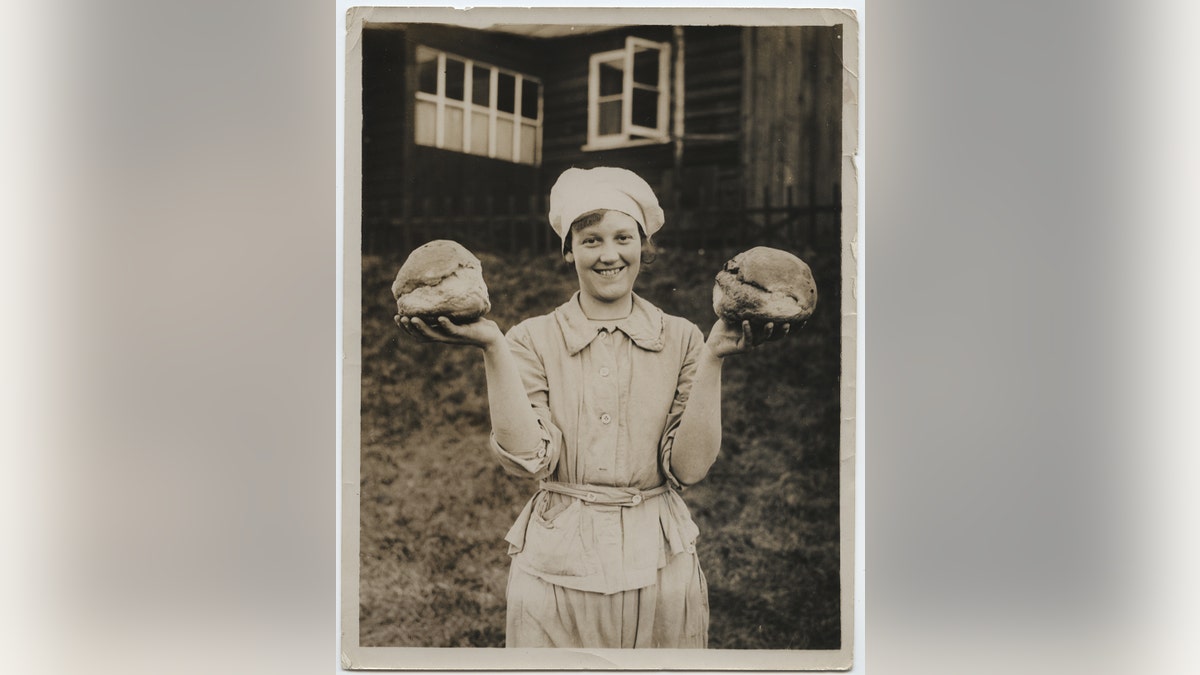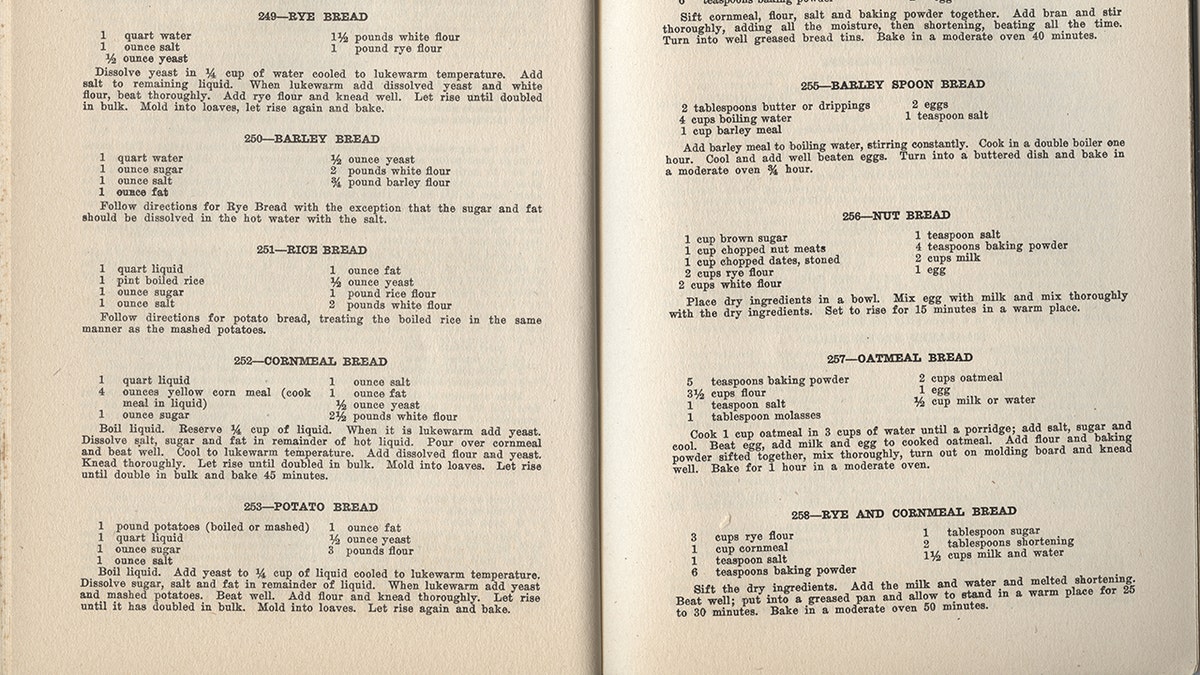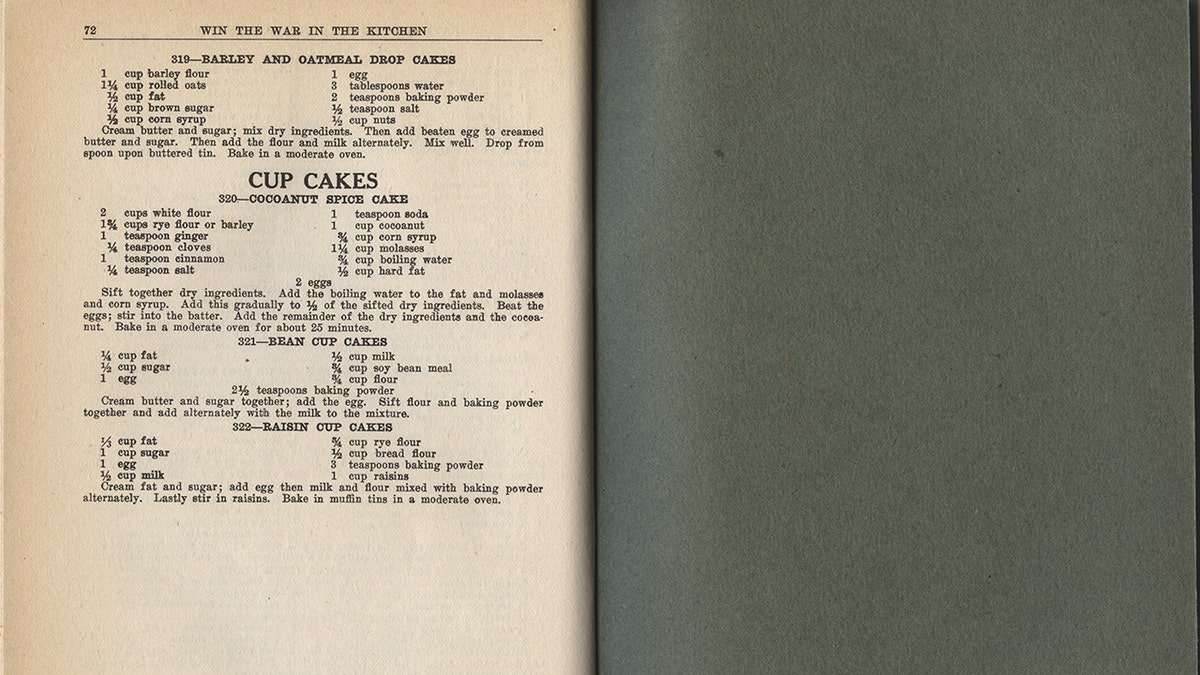
The recipes below were taken from the 1918 "Win the War in the Kitchen" cookbook, and shared with Fox News by the National WWI Museum and Memorial’s War Fare exhibit. (National WWI Museum and Memorial)
It’s not like you need another excuse to bake, with all of the trending recipes on the Internet these days. (We’re looking at you, sourdough bread and banana bread, and even you, frog bread.) But if you'll allow it, we'd like to give you one more reason: Sunday is World Baking Day.
This weekend, instead of going the expected route and using TikTok as your inspiration, try one of these turn-of-the-century recipes -- and don’t worry, none of them use yeast, or even much dairy or sugar.
"Recipe modifications that seem in alignment with the 21st century – for health or food sensitivities – are found throughout WWI cookbooks, including an emphasis on alternative flours. Barley, corn, rice, rye and potato flours were all promoted and encouraged to be used singularly or in conjunction with wheat flour," Lora Vogt, curator of education at the National WWI Museum and Memorial said to Fox News.
CLICK HERE TO SIGN UP FOR OUR LIFESTYLE NEWSLETTER
The recipes were shared with Fox News by the National WWI Museum and Memorial’s War Fare exhibit, specifically from the 1918 "Win the War in the Kitchen" cookbook, which urged cooks to get more creative by using "less dairy, fats and sugars" as a way to "voluntarily help the war effort and save food" during the war.
"Americans began using less of certain ingredients as well as finding substitutes. Meat, wheat, sugar and fat were all seen as necessary for 'boys on the front' – they could be easily shipped and are densely caloric to help one go the extra mile. This national push was occurring at the same time as the acceptance of nutrition science and home economics; there was a boom of new recipes that focused on substitutes for and reduced use – particularly of wheat," Vogt said.
Ready to put on your best early-20th-century apron and get sifting?

This weekend, instead of going the expected route and using TikTok as your inspiration, try one of these turn-of-the-century recipes. (National WWI Museum and Memorial)
If you’re a savory chef attempting to jump onto the baking bandwagon, “Liberty Bread” might be a good starting point.
"Liberty Bread"
Ingredients:
- 1½ cups white flour
- 1 cup cornmeal
- ½ cup bran
- 6 teaspoons baking powder
- 1 teaspoon salt
- 1½ cups liquid
- 2 tablespoons fat
- 1 egg
Directions:
- Sift cornmeal, flour, salt and baking powder together. Add bran and stir thoroughly, before adding all the moisture, then shortening (fat), beating all the time.
- Turn into well-greased bread tins.
- Bake in a moderate oven (350-375 degrees F) for 40 minutes.
FOLLOW US ON FACEBOOK FOR MORE FOX LIFESTYLE NEWS
Meanwhile, if you like your baked goods sweet and homey, good ol' fashioned cupcakes will be more your speed.

If coconut is not your favorite, the recipe comes with other flavor options like “Bean Cup Cakes” and “Raisin Cup Cakes.” (National WWI Museum and Memorial)
"Cocoanut Spice Cup Cakes"
Ingredients:
- 2 cups white flour
- 1¾ cups rye flour or barley
- 1 teaspoon ginger
- ¼ teaspoon cloves
- 1 teaspoon cinnamon
- ¼ teaspoon salt
- 1 teaspoon soda
- 1 cup cocoanut
- ¾ cup corn syrup
- 1¼ cup molasses
- ¾ cup boiling water
- ½ cup hard fat
- 2 eggs
Directions:
- Sift together dry ingredients. Set half aside. In another bowl, gradually add the boiling water to the fat and molasses and corn syrup. Add this gradually to one half of the sifted dry ingredients.
- Beat the eggs; stir into the batter.
- Add the remainder of the dry ingredients and the cocoanut. Pour into cupcake pans and bake in a moderate oven for about 25 minutes.
CLICK HERE TO GET THE FOX NEWS APP
If coconut isn't your favorite, the recipe comes with alternative bygone-era substitutions to make “Bean Cup Cakes” and “Raisin Cup Cakes.”
Just try and make sure to follow the antique recipes closely. You don’t want to wind up on Twitter’s baking failures.
